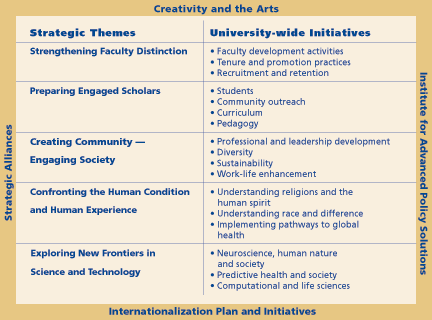Emory
Report homepage

January 29 , 2007
Strategic Plan Overview
Emory’s investment
impressive,
growing
by nancy seideman
Emory’s investment is impressive . . . and growing: $35 million for a Faculty Distinction Fund dedicated to the retention and recruitment
of excellent scholars . . .
$7 million annual investment in a financial aid program to slash debt burden for lower- and middle-income students . . . more than $171 million for capital projects, including support for a new school of theology and Ethics Center complex; a new psychology building; a major chemistry addition; new student housing and more.
All totaled, Emory will provide nearly half a billion dollars of its own resources (excluding capital) over the next decade to fulfill overarching University-wide strategic goals, and the plans of individual schools and major units.
Announcements of new funding for strategic initiatives means an investment in people, those who have built the foundation upon which the strategic plan was developed, and those who embody the University’s vision on a daily basis through their leadership, creativity, innovation, commitment . . . and hard, hard work.
This special issue of
Emory Report tells the University’s story through the voices of faculty, researchers, staff, students and health care providers who make the plan come alive every day through their teaching, research, service and patient care.
People like Keith Klugman whose research may mean that South African children will
be less likely to die of pneumonia related to influenza or
HIV . . . staff member James Roland who is helping colleagues establish a healthy
and productive work-life balance . . . nursing student Karen Thomisee who works with teens at Grady Memorial Hospital and travels internationally to assist with global health initiatives . . . business professor Michael Sacks who is leading students in a project to assess Atlanta city parks for the community.
“You can do it all at Emory,” is what Coach Christy Thomaskutty tells top scholar-athletes she’s recruiting for the women’s basketball team.
And we believe it, especially after meeting and reporting on the experiences of colleagues who are working to support the University’s strategic themes and initiatives, and leading the plans of individual schools and major units.
These 16 pages serve as a snapshot of where Emory is at the moment. It would take many more pages to merely list the number of initiatives, plans and percolating ideas taking place in this community today. By giving voice to the colleagues featured in this issue, we hope that we have captured the spirit, energy and commitment inherent in the entire Emory community.
After all, we have 10, 15, 30 years to tell many more stories.
Where Courageous Inquiry Leads
Emory University’s mission is to create, preserve, teach and apply knowledge in the service of humanity.
Vision
Emory is a destination university, internationally recognized as an inquiry-driven, ethically engaged and diverse community, whose members work collaboratively for positive transformation in the world through courageous leadership in teaching, research, scholarship, health care and social action.
Goal 1: Emory has a world-class, diverse faculty that establishes and sustains preeminent learning, research, scholarship and service programs.
Goal 2: Emory enrolls the best and the brightest undergraduate and graduate students and provides exemplary support for them to achieve success.
Goal 3: Emory’s social and physical environment enriches the intellectual work and lives of faculty, students and staff.
Goal 4: Emory is recognized as a place where engaged scholars come together in a strong and vital community to confront the human condition and experience and explore 21st century frontiers in science and technology.

How to get involved:
More than 1,000 faculty, staff, students and alumni worked for 18 months to get us to this point in the strategic plan process — it will take the entire community to make our collective vision a reality over the next decade and beyond.
There are many ways to take an active role in implementing the strategic plan: whether it’s serving on a standing committee, developing an idea for a strategic initiative, lending expertise to a particular project, mentoring students and colleagues, helping to plan and stage a program or volunteering for a community project . . . the opportunities are vast and the needs are many.
Here are just a few suggestions for getting started:
• The Strategic Implementation Advisory Committee, with University-wide
representation, is charged with coordinating and monitoring plan implementa-
tion, including recommending resource investment. For a list of committee
members and for more information, see The University Strategic Plan.
https://www.admin.emory.edu/StrategicPlan/
• Check the strategic plans of Emory schools and major operating units on their
individual Web sites.
• Submit your ideas to the Work-Life Task Force, a group dedicated to exploring
ways in which we can make our community more vibrant and our work
lives more fulfilling. https://www.admin.emory.edu/StrategicPlan/WorkLife/
• Comment on the strategic planning process and/or the implementation process.
https://www.admin.emory.edu/StrategicPlan/gencmmnt.html
• Get information about and provide input on the Clifton community.
http://www.cliftoncommunitypartnership.org/
• The Office of University-Community Partnerships maintains an electronic
bulletin board listing a variety of employment, volunteer service, and intern-
ship opportunities. http://www.oucp.emory.edu/Help.cfm
• Participate in a “Difficult Dialogue” through Emory’s Transforming Community
Project. http://www.transform.emory.edu/
• Explore more about the “Year of the Faculty.”
http://www.emory.edu/PROVOST/year/yearofthefaculty.html
• Get involved with a faculty development program.
http://www.emory.edu/PROVOST/acad_planning_fac_dev/index.html
TOP